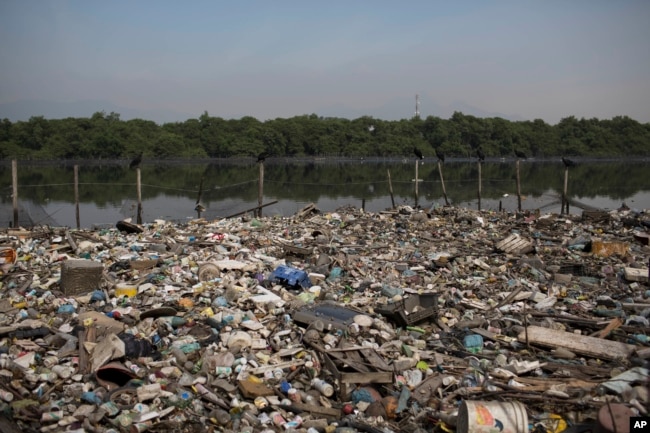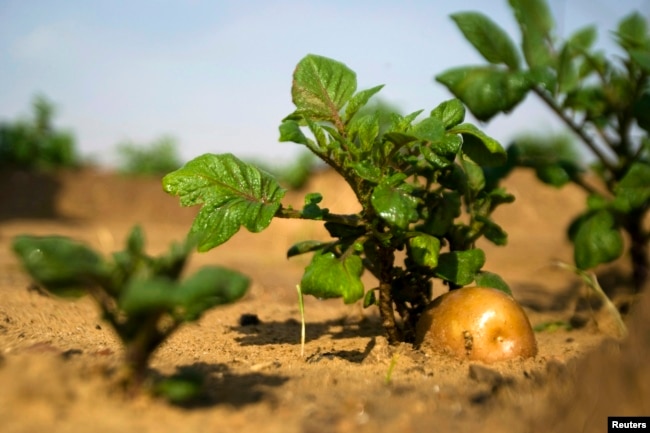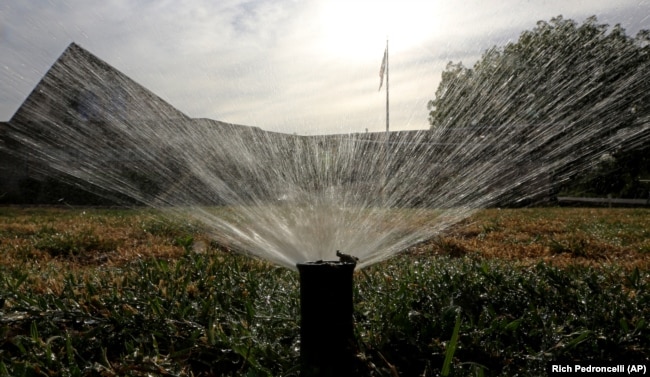Finding Solutions for World Water Shortage
Published on by Robert Brears, Founder of Our Future Water, Young Water Leaders, Mitidaption & Author (Springer Nature, Wiley) in Technology
Living things cannot survive without water.
By Kevin Eunochs and George Putic
Yet more than 700 million people worldwide have trouble getting clean, safe water. That number comes from the Water Project, a non-profit group. It estimates that one in nine people do not have access to safe and clean drinking water.

FILE: Trash floats on a polluted water channel that flows into the Guanabara Bay in Rio de Janeiro, Brazil, on May 15, 2014.
Governments, non-governmental organizations (NGO) and charities sent representatives to Stockholm, Sweden earlier this month for World Water Week activities. The subject for this year’s water week campaign was “water and waste, reduce and reuse.”
The United States Geological Survey defines wastewater as used water. It is the water that comes out of pipes from peoples’ homes — from their bathrooms, washing machines and dishwashers. It can contain substances such as human waste, food pieces, oils, and chemicals. Businesses and industries also use water that must be cleaned.
Wastewater can also have harmful substances that wash off roads, areas where motor vehicles are kept, and tops of buildings when it rains.
Todd Gartner of the World Resources Institute spoke with VOA from Stockholm by Skype. He says only a small amount of wastewater is being reused for other purposes.
"Something like, I think it’s only four or five percent of wastewater is being recycled for any useful purpose. And over 90 percent of wastewater is just raw water. Right, you obviously have some nutrients and some metals you have to filter out, but the technology is increasingly becoming available to treat and reuse that wastewater."

FILE - A potato grows in a field irrigated by recycled wastewater in Kibbutz Magen in southern Israel
Gartner says the simple step — reusing water — could make a big difference. He notes that recycling is already happening in some places.
"Even for potable water, there is a lot of places where they are treating the water to drinkable standards. And if you think about that as an option , it dramatically reduces our need to think of using fresh water each time."
Treating wastewater is good for human beings because it provides fresh water for us. But it also helps the environment by keeping waste out of rivers and oceans.
"Eighty percent of wastewater around the world is not treated at all. Which means that it is running into oceans and bays.”
Another problem is that people are using more clean water than our planet has. Sarah Feakins, a professor at the University of Southern California, spoke with VOA by Skype. She says agriculture is reducing the amount of water in the ground.
"It is well known that the water table level is dropping because of all the water being used for agriculture, so that means we can not keep doing what we are doing for a very long time. We actually have to change what we are doing."

FILE: Sprinklers water a grass lawn on July 15, 2014, in Sacramento, Calif.
Todd Gartner believes there are two kinds of solutions. One is low technology, like reforestation, or planting trees, and fixing pipes that leak. More high-tech solutions include better watering methods for agriculture, and factories to remove salt from salt water.
On average, the world uses about 10 billion tons of water a day. And while 75 percent of our planet is covered with water, only about two percent is fresh water — that comes from rivers, lakes, ice and snow.
The rest, 98 percent of the water, is in seas and oceans. It is too salty to drink. This is where desalination businesses come in.
The International Desalination Association, an industry group, says there are more than 19,000 desalination plants worldwide. They process more than 92 million tons of water every day. But they require a lot of energy. Currently, desalination operations are found mostly in coastal nations with large energy supplies. Examples are found in the Middle East.
Researchers are working to create a less costly technology. They are studying a process called membrane desalination. It moves water through special membranes that keep the larger salt molecules from passing through.
Nikolay Voutchkov is president of Water Globe Consultants. He says other technologies, such as using membranes with enzymes and nanoparticles , may cut the cost of using desalination for large amounts of water. He spoke to VOA by Skype.
“This type of structure, if we could imagine that we could generate that structure that looks like a honeycomb , we would increase production about 20 times to what we have today.”
Scientists say finding a less costly desalination process would mean less pressure on natural sources of clean water.
And Todd Gartner says everyone should have access to clean water.
"Water is a human right and we want to make sure that everyone has access to clean, pure plentiful water, right now, we are not allocating it in a way that suggests it is a human right and everyone deserves their equal share."
But for now, the world still faces each day with not having enough water for everyone.
Attached link
https://learningenglish.voanews.com/a/finding-solutions-for-world-water-shortage/4019331.htmlTaxonomy
- Drinking Water Security
- Standards & Quality
- Reclaimed Wastewater
- Raw Sewage Recycling
- Industrial Wastewater Treatment
- Decentralized Wastewater
- Water Reuse & Recycling
- Quality
- Water Security
- Meter Optimisation
- Smart Meters
- Wastewater Treatment
- Wastewater Collection
- Water Quality
- Water Cycle
- Solid Wastes & Wastewater Recycling
- Hydrodynamics & Water Quality
- Smart Metering
- Water Recycling
- Water Security
- Energy Efficiency
- Desalination
- Sustainable Desalination
- Water Utility
- Water Quality Management
- Water Quality Training
- Efficiency Improvement
- Water-Energy-Food-Security
- Water Quality Monitoring
- Recycling
- Water Purification
- Desalination
1 Comment
-
Dear Robert, congratulations for this very clear article in which you address few issues that are very important for the future development regarding the topic "water". Please allow for few comments:
1. Active now since more that 40 years as independent consultant in water treatment I surely do not belong to the "Young Water Leaders" by age, but would like to share the experience accumulated in many years and contribute to resolve problems under discussion in this group.
2. Facing the worldwide water stress, possible solutions should be considered in the sequence: a. reasonable use of potable water, means avoiding wasting water as it happens today in many areas; b. reuse/recycle water after the treatment/purification of wastewater as mentioned also in your article; c. produce potable water by treating contaminated surface water or e.g. desalination of brackish water or seawater. For the majority of these cases the most successful, resilient and resource efficient solutions can be based on membrane technology, if the related plants are designed, manufactured and operated adequately.
3. You cite IDA and the 19,000 desalination plants worlwide. But in our opinion the statement that these plants "require a lot of energy" is not retraceable . Using modern and up-to-date technology this kind of seawater desalination plants can be operated in the range of about 2.5 to 3.5 kWh per cubic meter of permeate (potable water), and - considering plants with a production capacity in the size of more about 50,000 cubic meter per day - for costs of less than one Euro per m3, OPEX nad CAPEX included.
4. As you correctly state researchers are working to create less costly technology. But the expectation addressing higher production you cite need for a long lapse of time. More promisng seems to be the implementation of technology that is available today but is not used as it could be by not retraceable reasons. This addresses i. a. the seawater intake systems, like e.g. subsurface units that allow to reduce or avoid chemical consumption, reduce energy demand and improve the resource efficiency. The same applies for seawater pumping systems or IT-based control devices and methodologies.
Future development should consider beside the hugh centralized plants in particular also decentralized plants. The technology is available.
Best regards
Thomas
Dr.-Ing. Thomas Peters
DPC senior technology consultant
1 Comment reply
-
Dear Thomas, the authors of the article are Kevin Eunochs and George Putic of VOA. Thank you.
-